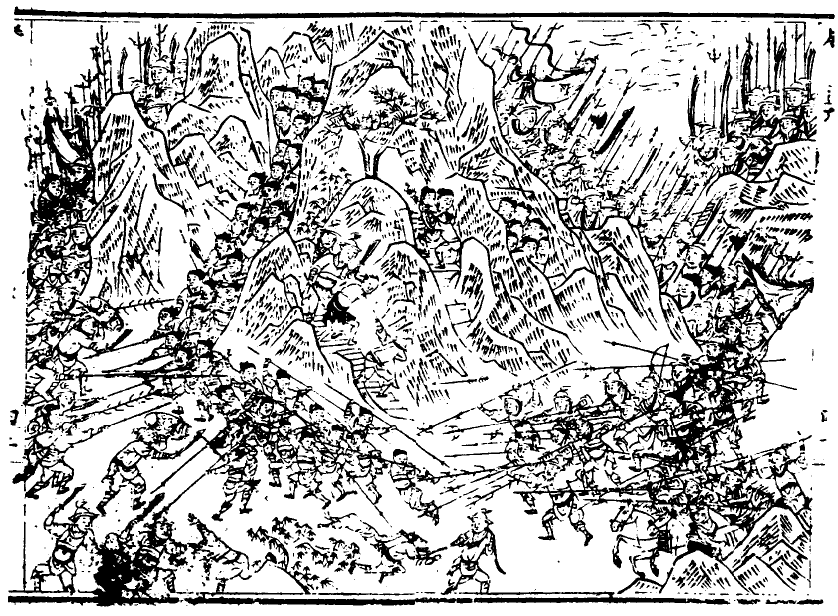 |
| 'Nan Ling Po Shan Kou Tu (《南嶺破山寇圖》)', a drawing from the book 'San Sheng Bei Bian Tu Ji (《三省備邊圖記》)' depicts Ming troops engaging a group of bandits. Swordsmen supported by Lang Xian (狼筅) flanked by two pikemen can be clearly seen at the bottom left of the picture. |
In his book Ji Xiao Xin Shu (《紀效新書》), general Qi Ji Guang (戚繼光) outlined a military drill participated by sixteen Mandarin Duck squads. This was a scaled down version of the actual order of battle. Qi Ji Guang also wrote down a larger order of battle participated by up to eight hundred men, but with similar tactics and manoeuvring.
Order of Battle
Marching in Column: Sixteen Mandarin Duck squads were divided into four platoons. First platoon was the vanguard, second and third platoon were left and right wing, and fourth platoon was the rearguard. The middle guard consisted of arquebusiers and field artillery.
Deployment for Combat: The army formed battle line in preparation to engage the enemy.
Manoeuvring: Second and third platoon split into half-platoon (two Mandarin Duck squads) to set up an ambush. Arquebusiers and artillery moved to the front of the vanguard, and commence firing.
Qi Ji Guang's arquebusiers were drawn up in five ranks and fire by rotation. Alternatively, all five ranks of arquebusiers could fire simultaneously in a very large salvo.
Engaging: After the opening volley, first and fourth platoon moved to the front to engage the enemy. Qi Ji Guang utilised a unit rotation system adopted from Yu Da You (俞大猷), in which first platoon would rotate with fourth platoon to recuperate and vice versa. If the battle was intense, fourth platoon would be called to reinforce the battle line, and both platoons would be fighting at the same time.
Meanwhile, second and third half-platoon would flank the enemy from both sides.
Feigning Retreat: First and fourth platoons as well as second and third half-platoon executed a feigned retreat. If enemy took the bait, ambushers would immediately commence attack.
Feigned retreat is a very difficult and risky tactics, especially if it is performed by infantry. Such manoeuvre requires truly extreme level of training and discipline.
Pincer Movement: Retreating platoons turned back, and all four platoons would attack the enemy simultaneously from five different directions.
Other blog posts in my Mandarin Duck Formation series:
Mi Zhan — the original Yuan Yang Zhen
Qi Ji Guang's Yuan Yang Zhen — Part 1
Qi Ji Guang's Yuan Yang Zhen — Part 2
Qi Ji Guang's Yuan Yang Zhen — Part 3
Qi Ji Guang's Yuan Yang Zhen — Part 4
Qi Ji Guang's Yuan Yang Zhen — Part 5
Qi Ji Guang's Yuan Yang Zhen — Part 6
Xu Guang Qi's Yuan Yang Wu






No comments:
Post a Comment